The Medium Voltage Digital Substation Market is estimated to be valued at USD 6.4 billion in 2025 and is projected to reach USD 11.7 billion by 2035, registering a compound annual growth rate (CAGR) of 6.3% over the forecast period.
Early growth is supported by utilities upgrading conventional substations to enhance operational efficiency, reliability, and fault detection capabilities. Integration of IoT-enabled sensors, real-time data analytics, and advanced control systems further strengthens adoption, enabling predictive maintenance and optimized energy management.
Over time, deployment extends to new installations and retrofit projects across industrial, commercial, and residential networks, reflecting the growing emphasis on resilient and intelligent power infrastructure. Year-on-year growth demonstrates a consistent upward trajectory, underpinned by regulatory mandates, grid modernization initiatives, and rising investments in renewable energy integration.
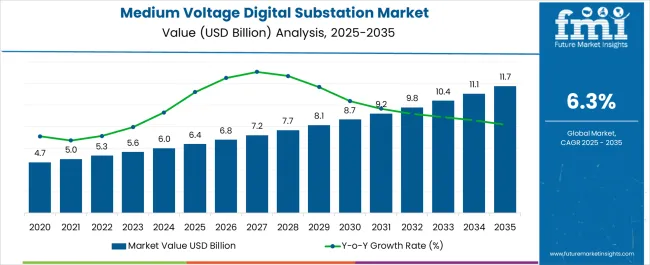
| Metric | Value |
|---|---|
| Medium Voltage Digital Substation Market Estimated Value in (2025 E) | USD 6.4 billion |
| Medium Voltage Digital Substation Market Forecast Value in (2035 F) | USD 11.7 billion |
| Forecast CAGR (2025 to 2035) | 6.3% |
The medium voltage digital substation market is experiencing notable expansion due to rising grid modernization efforts, increasing renewable energy integration, and the shift toward intelligent infrastructure. Utilities and industries are increasingly adopting digital substations to enhance reliability, enable real time monitoring, and reduce operational costs.
These substations offer advanced capabilities such as condition based maintenance, asset performance management, and seamless integration with digital communication protocols. The push for reduced downtime and efficient power distribution in both developed and developing regions has further accelerated deployment.
Digital substations also support scalable automation, remote operation, and improved fault response, aligning with evolving smart grid standards. The outlook remains strong as utilities, industries, and government bodies invest in technologies that enhance energy efficiency, optimize infrastructure performance, and support sustainable energy goals.
The medium voltage digital substation market is segmented by component, architecture, end-use, installation, and geographic region. By component, the medium voltage digital substation market is segmented into Substation automation systems, communication networks, electrical systems, monitoring and control systems, and Others. In terms of architecture, the medium voltage digital substation market is classified into Process, Bay, and Station. Based on end use, the medium voltage digital substation market is segmented into Utility and Industrial. By installation, the medium voltage digital substation market is segmented into New and Refurbished. Regionally, the medium voltage digital substation industry is classified into North America, Latin America, Western Europe, Eastern Europe, Balkan & Baltic Countries, Russia & Belarus, Central Asia, East Asia, South Asia & Pacific, and the Middle East & Africa.
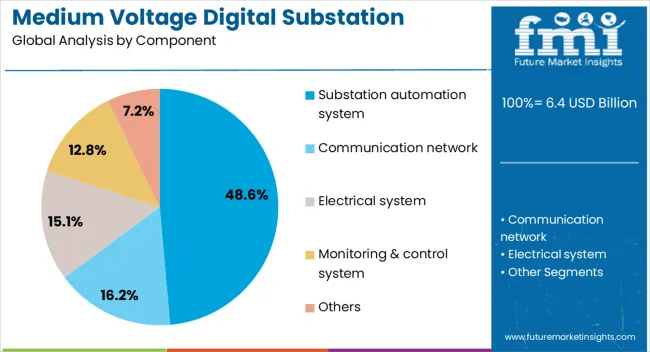
The substation automation system segment is expected to contribute 48.60% of total market revenue by 2025 within the component category, positioning it as the most prominent segment. This dominance is driven by its capability to improve control, enhance data acquisition, and optimize asset management in substations.
Automation systems facilitate faster fault detection, remote diagnostics, and real-time data analytics, significantly improving grid stability and operational efficiency. As the demand for uninterrupted power supply grows, utilities and industries are prioritizing systems that enable automated control and predictive maintenance.
The scalability and compatibility of these systems with legacy infrastructure have further supported their widespread adoption, solidifying their leadership in the component segment.
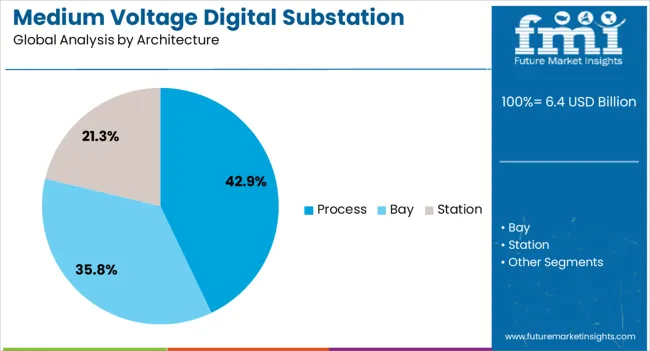
The process architecture segment is projected to account for 42.90% of total market revenue by 2025 within the architecture category, making it the leading sub segment. This is due to its direct integration of intelligent electronic devices into the primary equipment, which reduces wiring complexity, enhances data accuracy, and enables real time monitoring.
Process architecture supports interoperability and decentralized intelligence, improving system reliability and reducing costs associated with cabling and maintenance. Its adoption is also supported by the growing emphasis on standards-based communication protocols and cybersecurity frameworks.
The flexibility and responsiveness offered by this architecture continue to drive its preference in both greenfield and brownfield substation projects.

The utility segment is anticipated to contribute 57.30% of total market revenue by 2025 under the end-use category, establishing it as the dominant user segment. This leadership is driven by the sector’s strategic shift toward digitized infrastructure to meet evolving demand patterns, regulatory requirements, and renewable energy integration.
Utilities are increasingly relying on digital substations to optimize load flow, manage distributed energy resources, and enhance grid resiliency. Investments in smart grid development, aging infrastructure upgrades, and automation of transmission and distribution networks are further supporting market penetration.
The need for improved grid observability, real-time data, and efficient fault isolation is reinforcing the utility sector’s reliance on medium voltage digital substations, ensuring its continued dominance in the market.
The Medium Voltage Digital Substation market is driven by increasing demand for efficient grid management, technological integration, and regulatory support. Regions like North America and Asia-Pacific are witnessing significant adoption as they modernize their grids.
The Medium Voltage Digital Substation market is experiencing steady growth driven by the need for efficient power distribution and grid reliability. The integration of digital technologies into substations is expected to enhance grid performance and reduce operational costs. Utilities are increasingly focusing on adopting digital solutions that offer real-time monitoring, predictive maintenance, and automated fault detection. This transition is essential for maintaining a stable power supply in urban and industrial regions, where energy demand is rising. The rapid growth of renewable energy sources is further bolstering the adoption of digital substations to accommodate the variability and decentralized nature of renewable energy generation. The market is expected to expand as countries modernize their power infrastructure.
Digital substations are characterized by the integration of advanced communication systems, automation, and monitoring technologies that streamline operations. These technologies enable seamless data exchange, improved grid monitoring, and faster fault detection. The digitalization of substations allows operators to manage grid activities with precision, reducing human errors and enhancing decision-making. The ability to incorporate smart grids and real-time data is significantly improving grid stability, allowing for better load management and optimizing power flows. As a result, utilities are investing more in digital substation technology to meet growing demand for more resilient and intelligent power networks, ensuring a higher level of operational efficiency.
Government regulations and policy frameworks aimed at improving energy infrastructure and grid resilience are accelerating the adoption of digital substations. Various regions are introducing stricter grid reliability and modernization requirements, which encourage the implementation of digital solutions. In the European Union and North America, regulatory policies are facilitating the transition from traditional to digital substations. These policies support investments in smart grid technologies, providing a strong foundation for the expansion of digital substations. Governments are also offering financial incentives to utilities that implement digital substations to enhance grid stability and energy management. Such regulations are positioning digital substations as the go-to solution for modernizing power grids.
The demand for digital substations varies across regions, with North America, Europe, and Asia Pacific leading the way in adopting advanced grid technologies. In regions with mature power networks, such as North America and Europe, digital substations are becoming integral to grid modernization efforts. Meanwhile, in emerging economies like India and China, the push for upgrading outdated infrastructure is driving demand for more efficient digital substations. As these regions increase their power generation capacity and expand their grids, the integration of digital technologies will play a pivotal role. The rise of renewable energy sources and the need for robust grid management in these countries are expected to further fuel the market's growth.
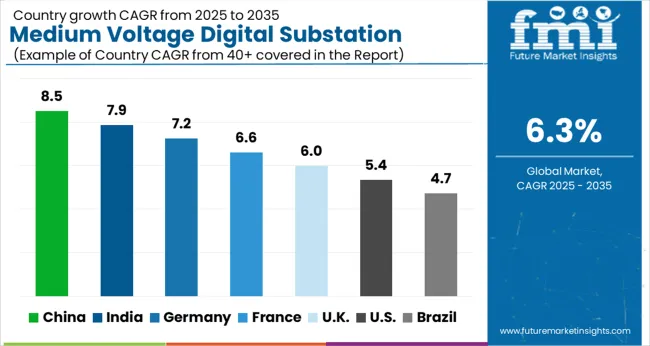
| Countries | CAGR |
|---|---|
| China | 8.5% |
| India | 7.9% |
| Germany | 7.2% |
| France | 6.6% |
| UK | 6.0% |
| USA | 5.4% |
| Brazil | 4.7% |
The medium voltage digital substation market is witnessing significant growth across multiple regions. China leads the market with a growth rate of 8.5%, driven by the rapid modernization of the country's power infrastructure and growing investments in grid digitalization. India follows closely with a 7.9% growth rate, as the country focuses on upgrading its power distribution systems to meet rising energy demands and improve grid efficiency. France is projected to see a 6.6% growth rate, supported by continued investments in smart grid technologies and digital substation upgrades. The UK is experiencing a 6.0% growth rate, driven by increased regulatory emphasis on grid resilience and digital transformation. Finally, the USA shows a 5.4% growth rate, with steady advancements in grid automation and efficiency through digital substations. These countries are shaping the future of the Medium Voltage Digital Substation market, with each contributing to the growing demand for intelligent and efficient grid solutions.
China is projected to post a CAGR of 8.5% for 2025–2035, higher than the 7.2% recorded during 2020–2024. This uplift is driven by continued industrialization, rapid grid modernization, and growing investments in power distribution infrastructure. The adoption of digital substations is being accelerated to handle increased renewable energy generation and to improve grid efficiency. As the demand for electricity surges, digital substations are seen as crucial for enhancing power stability and accommodating decentralized energy sources. The shift towards smart grids in major cities further boosts the adoption of digital technologies.
India is expected to achieve a CAGR of 7.9% for 2025–2035, up from 7.1% seen during 2020–2024. The market's rise is attributed to ongoing grid modernization projects and the increasing demand for more reliable and automated power distribution systems. India’s efforts to integrate renewable energy, such as solar and wind, have made digital substations essential for grid stability and efficiency. The country’s focus on improving energy access in rural areas further contributes to the growth of digital substations. Government policies promoting renewable energy integration and grid infrastructure upgrades provide a solid foundation for this growth.

France is projected to post a CAGR of 6.6% for 2025–2035, higher than the 6.1% seen in 2020–2024. The rise in market growth is driven by ongoing investments in grid modernization and the integration of renewable energy sources. France's commitment to energy transition goals has further accelerated the adoption of smart grid technologies. The demand for digital substations is growing as utilities look to improve grid efficiency, reliability, and reduce operational costs. The increasing penetration of electric vehicles also adds pressure on the grid, further pushing the need for smarter, more adaptable substations.
The UK is expected to achieve a CAGR of 5.9% for 2025–2035, an increase from 5.4% during 2020–2024. The market’s growth is largely due to increasing investments in grid automation and the integration of renewable energy. The UK government’s energy efficiency and smart grid initiatives have prompted utilities to prioritize digital solutions to enhance grid resilience and performance. The expansion of renewable energy sources, especially offshore wind, necessitates digital substations to handle variable power flows and improve grid reliability. These developments are driving the overall growth of the market in the UK
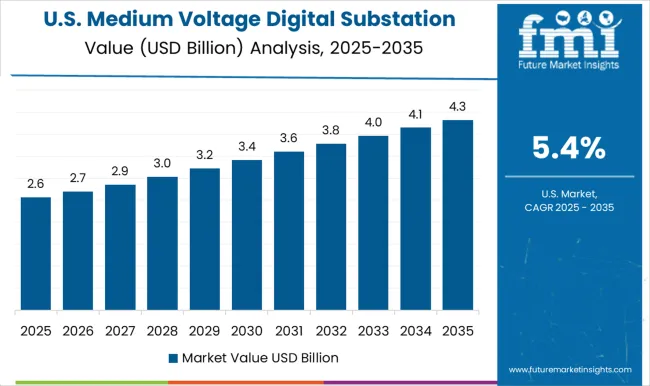
The medium voltage digital substation market in the USA is projected to post a CAGR of 5.4% for 2025–2035, which is slightly higher than the 5.2% recorded during 2020–2024. This growth is driven by the USA's continued efforts to upgrade its aging infrastructure and the increasing demand for more efficient and resilient power distribution systems. The push for greater integration of renewable energy sources, such as wind and solar, requires more advanced substation technology to ensure grid stability. Additionally, the rise of smart grid technology and the adoption of automation systems are key contributors to this market’s expansion. The ongoing regulatory push for cleaner and more efficient power generation systems further accelerates the transition to digital substations.
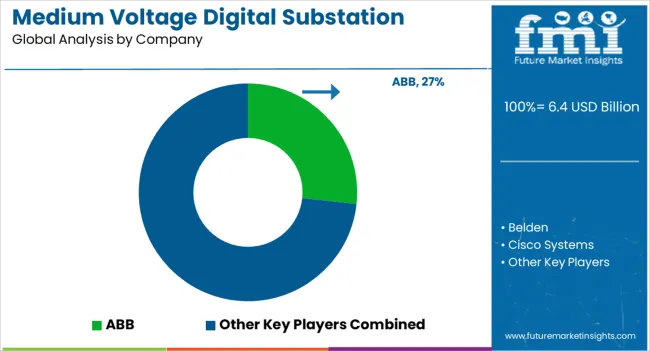
Leading players in this space include ABB, known for its innovative digital substation systems and integrated automation solutions for power distribution. Eaton delivers a comprehensive portfolio of digital substation solutions designed to improve grid automation, protection, and communication. Schneider Electric leads with its EcoStruxure Power solution, providing digital platforms that enhance energy management and reduce system downtime. Siemens remains a dominant force, offering comprehensive smart grid solutions and cutting-edge digital substations designed for real-time monitoring and enhanced grid flexibility. General Electric provides a range of digital substation products that integrate renewable energy sources and enable seamless integration of smart grid technologies. Hitachi Energy focuses on advancing the efficiency of electrical networks through its digital substation technologies that offer superior data analytics and predictive maintenance capabilities. Emerging players such as Cisco Systems and Toshiba also contribute to this competitive landscape, with Cisco focusing on communication infrastructure and network security solutions for smart grids, and Toshiba specializing in energy-efficient digital technologies and automation systems for power systems. Competitive strategies in this market include significant investments in R&D for advanced digital automation technologies, integration of renewable energy solutions, and the implementation of real-time monitoring and fault detection systems. Key market players are also focusing on strategic collaborations, partnerships with grid operators, and the development of tailored solutions that meet the growing demand for smarter, more resilient electrical grids.
| Item | Value |
|---|---|
| Quantitative Units | USD 6.4 Billion |
| Component | Substation automation system, Communication network, Electrical system, Monitoring & control system, and Others |
| Architecture | Process, Bay, and Station |
| End Use | Utility and Industrial |
| Installation | New and Refurbished |
| Regions Covered | North America, Europe, Asia-Pacific, Latin America, Middle East & Africa |
| Country Covered | United States, Canada, Germany, France, United Kingdom, China, Japan, India, Brazil, South Africa |
| Key Companies Profiled | ABB, Belden, Cisco Systems, Eaton, Efacec, General Electric, Grid to Great, Hitachi Energy, Larsen & Toubro Limited, Netcontrol Group, Schneider Electric, Siemens, SIFANG, Tesco Automation, Texas Instruments Incorporated, and Toshiba |
| Additional Attributes | Dollar sales and share over the forecast period, particularly from 2024 to 2035. |
The global medium voltage digital substation market is estimated to be valued at USD 6.4 billion in 2025.
The market size for the medium voltage digital substation market is projected to reach USD 11.7 billion by 2035.
The medium voltage digital substation market is expected to grow at a 6.3% CAGR between 2025 and 2035.
The key product types in medium voltage digital substation market are substation automation system, communication network, electrical system, monitoring & control system and others.
In terms of architecture, process segment to command 42.9% share in the medium voltage digital substation market in 2025.
Explore Similar Insights

Thank you!
You will receive an email from our Business Development Manager. Please be sure to check your SPAM/JUNK folder too.
Chat With
MaRIA